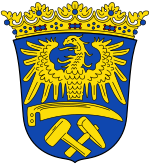Upper Silesia Province
| flag | coat of arms |
|---|---|

|

|
| Situation in Prussia | |

|
|
| Consist | 1919-1938, 1941-1945 |
| Provincial capital | Opole , from 1941 Katowice |
| surface | 9,702 km² |
| Residents | 1,482,765 (1933) |
| Population density | 152.8 inhabitants / km² |
| Arose from | Province of Silesia |
| Today part of |
Opole Voivodeship , Silesian Voivodeship ( PL ) Moravskoslezský kraj - Moravian-Silesian Region ( Hultschiner Ländchen ) ( CZ ) |
| map | |

|
|
The Prussian province of Upper Silesia was created after the First World War by dividing the Province of Silesia into the two new provinces of Lower Silesia and Upper Silesia . East Upper Silesia , ceded to Poland in 1922 , formed the Autonomous Silesian Voivodeship with the capital Katowice . Before, both parts of Upper Silesia were combined in the Opole administrative district.
history
After the Migration Period , the Slavic Opolans (the capital Opole is named after them ) came into the country and occasionally mixed with the Germans who had stayed behind . In the course of the Middle Ages , German settlers also came to Upper Silesia.
At the end of the 19th and beginning of the 20th century, urbanization increased sharply in Upper Silesia, which was characterized by the mining industry . In addition to the Upper Silesian-speaking Silesians, there were also many Germans from Lower Silesia and the neighboring Austrian regions as well as a large number of Poles from the Prussian province of Posen or the neighboring Russian " Congress Poland " to Upper Silesia.
After the First World War, according to the Versailles Treaty, parts of the border between the newly founded Poland and the German Reich were to be regulated by referendums . Between the end of the war and the referendum in Upper Silesia , there were violent clashes (three uprisings in Upper Silesia ) between Polish residents, who demanded annexation to Poland, and German police units and volunteer corps . On the voting day of March 20, 1921 (with a turnout of 97.8%) 707,554 Upper Silesians (59.6%) voted to stay with Germany, while 478,820 (40.4%) voted for Poland.
In May there was another uprising with the aim of complete annexation to Poland, but it was unsuccessful. After that, the smaller (29%) part of Upper Silesia (" East Upper Silesia "), but with it the majority of the Upper Silesian industrial area with half of all smelting works, a large part of the coal and iron ore deposits and the economically important mining regions , was decided by the League of Nations on October 10, 1921 Poland struck. The cities and industrial towns of Königshütte , Kattowitz , Myslowitz , Laurahütte , Bismarckhütte , Schwientochlowitz , Lipine , Godullahütte , Morgenroth and Ruda became Polish. The rest stayed with Germany ("West-Oberschlesien"); part of the Ratibor district , the so-called Hultschiner Ländchen , had already been ceded to Czechoslovakia on January 10, 1920 when the Versailles Treaty came into force .
On September 3, 1922, a referendum was held in the part of Upper Silesia that remained German, in which a decision was to be made about the formation of a separate state of Upper Silesia in the German Reich. However, over 90% were in favor of the previous status quo , i.e. the remaining of Upper Silesia in the Free State of Prussia of the German Empire during the Weimar Republic . From 1938 to 1941, Upper Silesia was combined with the Province of Lower Silesia to form the Province of Silesia . From 1941 until the end of the war in 1945, Upper Silesia was again an independent province.
At the end of the Second World War , Upper Silesia was conquered by the Red Army in 1945 and fell to Poland , except for the Hultschiner Ländchen , which came back to Czechoslovakia. In contrast to Lower Silesia, there was no compulsory resettlement in the Upper Silesian industrial area for ethnic or economic reasons, as many residents were bilingual because they either used the Silesian dialect or had to (compulsorily) learn Polish in the Silesian Voivodeship during the period between the World Wars . In addition, many Upper Silesians had professional qualifications that could not be replaced in the coal and steel industry at short notice. Anyone who passed a more or less strict Polish language test and was classified as “autochthonous” was granted the right to stay. Upper Silesians, who were classified as (only) German-speaking, were given the right to stay if they worked in important industries. After all, “only” about 40% of the Upper Silesian population and not more than 90%, as in Lower Silesia, were forcibly resettled. In particular around Opole and Kattowitz , a German minority remained until today.
Today most of Upper Silesia belongs to Poland and the Hultschiner Ländchen to the Czech Republic . The region is also home to the largest ethnic minority in Poland after the ethnic Silesians (2002 census), the Polish Germans . Around 250,000 residents of Silesia have had German citizenship in addition to Polish citizenship since 1991 .
See also: Silesia (history)
Area and population
Province of Silesia: 37,013 km²; 4,846,333 inhabitants (May 1939), the majority of whom were Roman Catholic , which was a (further) special feature, since the majority in eastern Germany was Protestant .
politics
Administrative division of Upper Silesia
Originally the province of Upper Silesia consisted only of the administrative district of Opole , from which East Upper Silesia then left as the Silesian Voivodeship in 1921 and became part of Poland. During the Second World War, these areas were combined with some other districts and sub-districts that were Austrian or Russian until 1918 to form the administrative district of Katowice .
Administrative structure as of January 1, 1945
Katowice Governorate
|
City districts Counties
|
Opole administrative district
|
City districts Counties |
|
Administrative structure today
The province was dissolved in 1945 and joined the Silesian Voivodeship .
Chief President
- 1919–1922: Joseph Bitta , center
- 1923–1929: Alfons Proske , center
- 1929–1933: Hans Lukaschek , center
- 1933–1934: Helmuth Brückner , NSDAP
- 1935–1938: Josef Wagner , NSDAP
- 1938–1941: Province of Silesia
- 1941–1945: Fritz Bracht , NSDAP
Provincial Parliament
1925: Center 48.2% - 26 seats | DNVP 20.9% - 12 seats | SPD 8.5% - 5 seats | KPD 8.4% - 5 seats | Poland 7.2% - 4 seats | DDP 2.2% - 2 seats
1929: Center 42.2% - 24 seats | DNVP 17.3% - 10 seats | SPD 12.2% - 7 seats | KPD 8.9% - 5 seats | Poland 5.7% - 3 seats | Christian National Peasant and Rural People's Party 4.7% - 3 seats | OBB 4.4% - 3 seats
1933: NSDAP 43.1% - 24 seats | Center 33.3% - 18 seats | DNVP 8.3% - 5 seats | SPD 6.6% - 4 seats | KPD 6.4% - 4 seats
100% missing votes = nominations not represented in the provincial assembly.
Development of the ethnolinguistic structure
| year | Polish | German | ||
|---|---|---|---|---|
| absolutely | percentage | absolutely | percentage | |
| 1819 | 377.100 | 67.2% | 162,600 | 29.0% |
| 1828 | 418,437 | 255.383 | ||
| 1831 | 456.348 | 257.852 | ||
| 1837 | 495,362 | 290.168 | ||
| 1840 | 525.395 | 330.099 | ||
| 1843 | 540.402 | 348.094 | ||
| 1846 | 568,582 | 364.175 | ||
| 1852 | 584.293 | 363,990 | ||
| 1858 | 612,849 | 406,950 | ||
| 1861 | 665.865 | 409.218 | ||
| 1867 | 742.153 | 457,545 | ||
| 1890 | 918.728 | 58.2% | 566,523 | 35.9% |
| 1900 | 1., 048.230 | 56.1% | 684.397 | 36.6% |
| 1905 | 1,158,805 | 56.9% | 757.200 | 37.2% |
| 1910 | 1,169,340 | 53.0% | 884.045 | 40.0% |
See also
- Landsmannschaft der Oberschlesier
- Federation of Upper Silesians
- Our Upper Silesia
- Church tracing service
- Gau Upper Silesia
- New Silesia
literature
- Bernhard Sauer: "On to Upper Silesia" - The fighting of the German Freikorps in 1921 in Upper Silesia and the other former German eastern provinces . (PDF; 7.6 MB) In: Zeitschrift für Geschichtswwissenschaft , Volume 58 (2010), Issue 4, pp. 297-320
- Joseph Partsch : Silesia: a regional study for the German people. T. 1., The whole country . Ferdinand Hirt publishing house, Breslau 1896.
- Joseph Partsch: Silesia: a regional study for the German people. T. 2., Landscapes and Settlements . Ferdinand Hirt publishing house, Breslau 1911.
- Lucyna Harc et al .: Cuius regio? Ideological and Territorial Cohesion of the Historical Region of Silesia (c. 1000-2000) vol. 4., Region Divided: Times of Nation-States (1918–1945) (PDF) eBooki.com.pl, Wrocław 2014, ISBN 978-83-927132-8-9
- Paul Weber: The Poles in Upper Silesia: a statistical study . Julius Springer's publishing bookstore, Berlin 1913, archive.org
Individual evidence
- ↑ Referendums in Upper Silesia 1920-1922 , Gonschior.de
- ^ The referendum in Upper Silesia in 1921 , Landsmannschaft der Oberschlesier, Landesverband Baden-Württemberg e. V. and district group Karlsruhe
- ↑ Georg Hassel: Statistical outline of the entire European and the most distinguished non-European states, in terms of their development, size, population, financial and military constitution, presented in tabular form . First issue: Which represents the two great powers Austria and Prussia and the German Confederation . Verlag des Geographisches Institut, Weimar 1823, p. 34; (Total population in 1819: 561,203; Moravians: 12,000; Jews: 8,000 and Czechs: 1,600)
- ↑ a b c d e f g h i j Paul Weber: The Poles in Upper Silesia: a statistical study . Julius Springer's publishing bookstore, Berlin 1913, pp. 8–9
- ^ A b c d Paul Weber: The Poles in Upper Silesia: a statistical study . Julius Springer's publishing bookstore, Berlin 1913, p. 27



